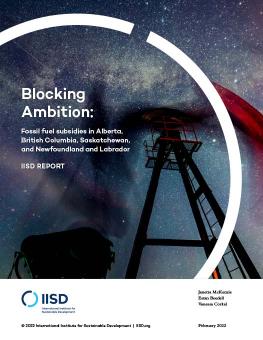
Blocking Ambition: Fossil fuel subsidies in Alberta, British Columbia, Saskatchewan, and Newfoundland and Labrador
This report examines levels of fossil fuel subsidies in Canada's main fossil fuel-producing provinces: British Columbia, Alberta, Saskatchewan, and Newfoundland and Labrador. In total, these four provinces provided at least CAD 2.5 billion in fossil fuel subsidies in fiscal year (FY) 2020/21 and 1.5 billion in FY 2021/22 (as of December 2021). Provinces are diverting significant public funds to incentivize fossil fuel production that may not otherwise occur, and provincial governments are missing out on millions in uncollected royalty and tax revenue from fossil fuels.
-
Canada's four fossil fuel-producing provinces provided CAD 2.5 billion in fossil fuel subsidies in the 2020/21 fiscal year.
-
Provinces have doubled down on fossil fuels as a pandemic recovery strategy, adding new subsidies despite the economic and climate risks.
-
Without action by provinces, Canada cannot achieve its climate targets and limit warming to 1.5°C.
Phasing out fossil fuel subsidies in Canada requires provinces to step up. While the federal government has committed to ending fossil fuel subsidies by 2023, movement on the subsidy file cannot rely on federal commitments alone. This report examines levels of fossil fuel subsidies in Canada’s main fossil fuel-producing provinces: British Columbia, Alberta, Saskatchewan, and Newfoundland and Labrador.
In total, these four provinces provided at least CAD 2.5 billion in fossil fuel subsidies in fiscal year (FY) 2020/21 and 1.5 billion in FY 2021/22 (as of December 2021).
Provinces are diverting significant public funds to incentivize fossil fuel production that may not otherwise occur, and provincial governments are missing out on millions in uncollected royalty and tax revenue from fossil fuels.
Key findings:
- British Columbia provided CAD 765.3 million in subsidies in FY 2020/21. The province continues to support liquefied natural gas, undermining the CleanBC plan as well as any other climate progress the provincial government is making.
- Alberta’s subsidies totalled CAD 1.32 billion in FY 2020/21. Alberta committed to fossil fuel production as a pandemic recovery strategy, increasing subsidies and dispensing the Technology, Innovation and Emissions Reduction (TIER) Fund in ways that incentivize fossil fuel production.
- Saskatchewan provided subsidies of CAD 409.3 million in FY 2020/21 and has introduced new subsidies in recent years, such as drilling incentives for producers.
- Newfoundland and Labrador’s subsidies totalled CAD 82.6 million in FY 2020/21. Subsidies are increasing, and recent changes to the royalty structure for the Terra Nova oil field will cost taxpayers an additional CAD 300 million over the lifespan of the project.
Funded by
You might also be interested in
Doubling Down on Alberta's Oil and Gas Sector Is a Risk Canadians Can’t Afford to Take
There's no question that people across Alberta need urgent help. But is injecting tens of billions into oil and gas corporations the right kind of help?
How Fossil Fuels Drive Inflation and Make Life Less Affordable for Canadians
New report takes closer look at how Canada’s dependence on fossil fuels impacts energy costs and prices of essentials such as transportation, home heating, and housing.
The Indonesia Cooking Diaries Study
This study evaluates the feasibility and implications of switching from cooking with LPG to induction stoves in Indonesian households.
Report Calls on Fossil Fuel Producers to Map “Transition Away” in NDCs
With governments due to submit the next generation of NDCs in 2025 a new report identifies five elements countries should include to reflect the outcome of the global stocktake.